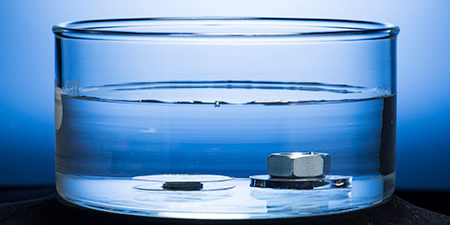University of Rochester scientists have figured out how to make unsinkable metals using superhydrophobic (water repelling) materials. To accomplish this, they created structures made up of two treated aluminum surfaces facing each other, connected by a small central pole, designed to trap the maximum amount of air. What they ended up with was a virtually unsinkable metal.
The structure uses a groundbreaking technique the lab developed for using femtosecond bursts of lasers to “etch” the surfaces of metals with intricate micro- and nanoscale patterns that trap air and make the surfaces superhydrophobic, or water repellent.
The scientists found, however, that after being immersed in water for long periods of time, the surfaces may start to lose their hydrophobic properties.
Enter the spiders and fire ants, which can survive long periods under or on the surface of water. How? By trapping air in an enclosed area. Argyroneta aquatic spiders, for example, create an underwater dome-shaped web—a so-called diving bell— that they fill with air carried from the surface between their super-hydrophobic legs and abdomens. Similarly, fire ants can form a raft by trapping air among their superhydrophobic bodies.
“That was a very interesting inspiration,” Chunlei Guo, professor of optics and physics says. As the researchers note in the paper: “The key insight is that multifaceted superhydrophobic (SH) surfaces can trap a large air volume, which points towards the possibility of using SH surfaces to create buoyant devices.”
Guo’s lab created a structure in which the treated surfaces on two parallel aluminum plates face inward, not outward, so they are enclosed and free from external wear and abrasion. The surfaces are separated by just the right distance to trap and hold enough air to keep the structure floating—in essence creating a waterproof compartment.
Even after being forced to submerge for two months, the structures immediately bounced back to the surface after the load was released, Guo says. The structures also retained this ability even after being punctured multiple times, because air remains trapped in remaining parts of the compartment or adjoining structures.
Though the team used aluminum for this project, the “etching process “could be used for literally any metals, or other materials,” Guo says.
When the Guo lab first demonstrated the etching technique, it took an hour to pattern a one-inch-by-one-inch area of surface. Now, by using lasers seven times as powerful, and faster scanning, the lab has speeded up the process, making it more feasible for scaling up for commercial applications.















